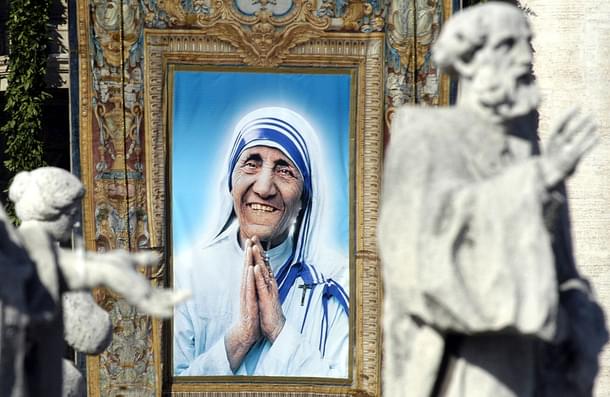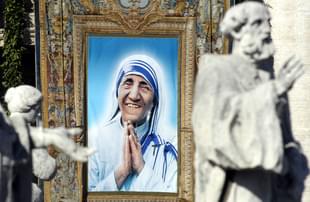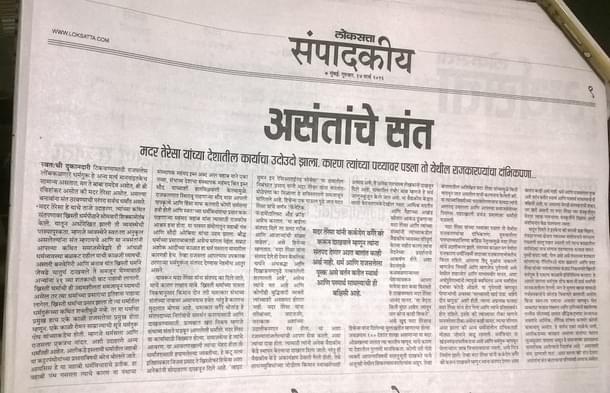Columns
The ‘Miracle’ Of Mother Teresa And A Curious Case Of A Daily’s Editorial
Swarajya Staff
Mar 23, 2016, 02:54 PM | Updated 02:53 PM IST
Save & read from anywhere!
Bookmark stories for easy access on any device or the Swarajya app.


—Withdraws and apologises for it the next day
Why?
On March 17, Marathi daily ‘Loksatta’ published an editorial critical of Mother Teresa and her works. However, the next day the editor ‘withdrew’ the editorial and also apologised for it on page one. This, when there was no palpable threat to the editor or Loksatta. Given below are excerpts from a message received on March 18 from a Maharashtra-based journalist (name withheld on request) who was flummoxed by this inexplicable decision of the Loksatta editor.
Leading Marathi newspaper ‘Loksatta’ of the Indian Express group carried an editorial in its edition March 17 on the issue of sainthood being conferred on Mother Teresa. The editorial questioned Mother Teresa’s work, her claims of charity in India, the support she got for Christian countries for her work elsewhere and in countries like India, the comfortable ecosystem the Congress party provided her with . . . and the overall hypocrisy of this practice. While the editorial made critical comments on such practices, quacks, and so called spiritual gurus in all faiths, its main target was Mother Teresa and the sainthood bunkum.
The editorial had a great reception and was widely shared, especially by those on the RSS-BJP side of the argument against Mother Teresa.
But the real journalistic shock happened the next day. On page one of Loksatta, the editor published an apology for the editorial, and shockingly, has ‘withdrawn’ it, whatever that means. It is a personal apology by the editor and not by the newspaper or the proprietor. The apology says the editorial hurt the sentiments of readers and the editor apologises for it and is withdrawing it.
No other explanation has been given. Interestingly, today’s Loksatta edition also carries a bunch of letters to the editor against the editorial. No writer of the letter to the editor has demanded that the editorial be withdrawn.
The editor in question, Girish Kuber, has been quite a critical voice of the BJP, RSS, and Modi all along. In fact his enthusiasm to criticise BJP, Modi, and RSS has at times blinded him to facts and perspective. BJP or Modi are not the only targets. Even an editorial that mocked farmers and their demand for debt waivers was written in an extremely unkind, self-righteous, and arrogant diction.

A particular editorial defending Yakub Memon and criticising his death sentence was full of factual errors, errors of judgement, and a near total lack of perspective. Yet, those editorials have been read, criticised, and even Loksatta has carried letters against them.
But one editorial critical of Mother Teresa and hypocritical elements within Christianity, and the editor apologises and withdraws it. What is happening?
Translated copy of the editorial
“Saints of the non-saints
Mother Teresa’s work in India got glorified because of help from the hypocrisy of our politicians
The so called religious leaders who cling to the political power of the day to run their shops are as ordinary as the normal mortals. Be it Baba Ramdev or Sri Ravishankar or Mother Teresa. All religions have traditions to anoint such fake religious leaders as saints. Mother Teresa is the latest instance. The Vatican Church on Monday confirmed the so-called sainthood for Mother Teresa. What this decision underlines is the mutual interdependence of the system. This interdependence is manifest in the system declaring those favourable to it ‘saints’ and these neo-saints then through their so-called social service making sure this blind religious order is further strengthened. Others outside the system had to wait till the 21st century to understand the cleverness demonstrated by Christianity in deploying this fraud and its fraudulent means. To understand this enterprise of Christianity one must look into the history of the expansion of Christianity. Christianity expanded not because of the so-called collective religious power of the priests but because the religious head was also the head of the State at one point of time. This was the time when the reins of the Roman empire were in the hands of the Pope. So the religious power and the political power were concentrated in a single entity. Other religions too have such instances. A reference could be made to the current discourse about the spread of Wahhabism within Islam. The Islamic State (ISIS) is the symbol of the Wahhabi religious streak. Wahhabism spread because its founder Mohammad ibn Abd al-Wahhab struck an alliance with Mohammad bin ibn Saud, the founder of a new and likely nation. Saud who wanted to settle in politics needed a religious cover that would condone his sins and violence while Mohammad Wahhab was looking for the political patronage for the expansion of his religious thought. Wahhabism and Saudi Arabia emerged out of this mutually beneficial alliance. Same could be said of the spread of Buddhism. It spread during the reign of Ashoka precisely for this reason. So the political power is always eager to confer sainthood on those who are considered beneficial to it. This should explain the reason why sainthood has been conferred on Mother Teresa.
In Christianity a prospective saint must have performed at least two miracles to be anointed saint. But this eligibility itself is fundamentally fraud. The miracle rubbish is merely the stated reason for public consumption to justify the decision to confer sainthood. The real eligibility criterion is the number of conversions the prospective saint has carried out. Mother Teresa was well known for this work. Charity was only the cover for this work. Her real face was of a person craving conversions. This bitter truth has been brought out well by historian Vijay Prasad and Christopher Hitchens and many others. In an essay in his book titled ‘White Woman in Racialized Spaces’ Vijay Prashad explains in detail why Mother Teresa got so much of importance in India. Hitchens goes a step forward describing Mother Teresa as ‘fanatic, fundamentalist, and fraud’. “If this woman is chosen for sainthood the number of the poor and the sick would in fact rise,” Hitchens says. “The decision to confer sainthood on Mother Teresa is Roman Catholic Church’s surrender to superstition and superficiality” is Hitchen’s observation and no intellectual person will disagree with this observation. Mother Teresa was interested in glorification of the poor, the destitute, the abject, and the sick. She claimed that she was serving such downtrodden lot. A reference is made, by way of evidence of this service to the poor, to the many medical aid centres that she founded. But these medical aid centres were deliberately kept inefficient. Several Western writers have shown that apart from the shortage of equipment and facilities these centres also did not have basic sanitation facilities. They did not even have basic pain killers. The most serious aspect of all this was that this was all done deliberately. Despite being flush with funding and perennial sources of funding, Mother Teresa and the institutions she set up did not fully equip their medical centres with facilities precisely because they were more attracted towards the exhibition of pain and poverty. Her joy was in showing off how compassionately she caressed the faces so contorted by pain and poverty. “This pain is so beautiful. The world learns so much from it,” is what Mother Teresa herself said in an interview to Hitchens.
Mother Teresa and her work have branches in nearly 100 countries yet she is known as an Indian. The reason for this is the slave mentality in this country. Even today the educated in this country are fascinated by a white person showing sympathy for us. So one can imagine how mesmerised the illiterate people in Bengal felt by Mother Teresa. She deftly exploited this very fascination for her and under the innocent cover of charity carried out large scale conversions.
What came in handy for Mother Teresa was the hypocrisy of our politicians. Initially her glorification happened because of the foreign-friendly and westernised Congress leadership. Later the Indian politics got stuck in the secular-non-secular narrative. Denying our Hindu roots became the default setting for secularism and by inference liberalism for our liberals and media functionaries. These half liberals rarely criticised the hypocrisy within other religions. They attacked hypocrisy within Hinduism but became mute when it came to criticising the same within other religions. All this indirectly helped Mother Teresa and her glorification. So much so that any criticism of Mother Teresa was considered akin to criticising humanity itself. As a consequence of this hypocrisy within other religions also started increasing with great force. A picture got created that any religious thought and the self-appointed religious leaders were beyond scrutiny and criticism. Hence the justification that sainthood is being conferred on Mother Teresa because she performed the miracle of curing cancer has no meaning whatsoever. The sainthood is a reward for a conduct beneficial to both, the religious power and the political power, and for serving the right ends in both material and metaphysical worlds. If real power indeed lied with such fake saints, then the western civilisation from where Mother Teresa comes would not have wasted time in science and research.
All this only shows that while human talent strives to scale greater heights in scientific research, progress, and technology, the religious power continues to take pride in being stuck in its backwardness. The Christian priests who harassed Galileo in the 15th century for concluding that the earth is round and not flat and the Christian priests who promote fake stories of Mother Teresa’s miracles represent the same age. Such backward religious leaders are the only net contribution of all religions to humanity. Be it a Balaji who sells some Garbha Sanskar for a male child or a Baba or Bapu who calls himself an avatar of Ram, younger brother Laxman, and his jewellery-laden wife Sita and carries out economic or sexual exploitation of his intellectually inefficient devotees. They all are of the same type. Of late such fake saints have mushroomed in India and this is symptomatic of a larger social malaise. The true saints advise us all to stay away from the fake ones lest their company might cost us our lives. The decision to call a non-saint saint may just prove to be the same. “




